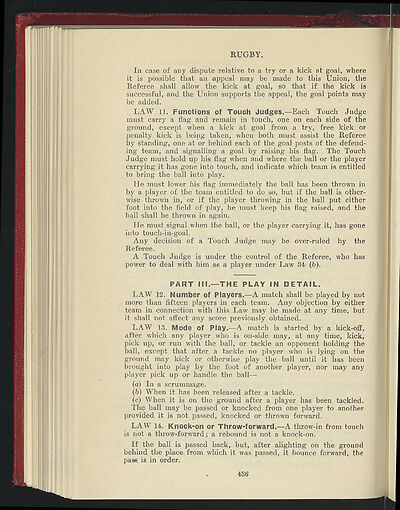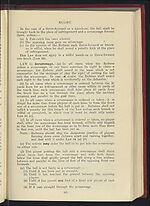1936-37
(458)
Download files
Complete book:
Individual page:
Thumbnail gallery: Grid view | List view

RUGBY.
In case of any dispute relative to a try or a kick at goal, where
it is possible that an appeal may be made to this Union, the
Referee shall allow the kick at goal, so that if the kick is
successful, and the Union supports the appeal, the goal points may
be added.
LAW 11.
Functions of Touch Judges.
—Each Touch Judge
must carry a flag and remain in touch, one on each side of the
ground, except when a kick at goal from a try, free kick or
penalty kick is being taken, when both must assist the Referee
by standing, one at 'or behind each of the goal posts of the defend-
ing team, and signalling a goal by raising his flag. The Touch
Judge must hold up his flag when and where the ball or the player
carrying it has gone into touch, and indicate which team is entitled
to bring the ball into play.
He must lower his flag immediately the ball has been thrown in
by a player of the team entitled to do so, but if the ball is other-
wise thrown in, or if the player throwing in the ball put either
foot into the field of play, he must keep his flag raised, and the
ball shall be thrown in again.
He must signal-when the ball, or the player carrying it, has gone
into touch-in-goal.
Any decision of a Touch Judge may be over-ruled by the
Referee.
A Touch Judge is under the control of the Referee, who has
power to deal with him as a player under Law 34 (b).
PART 111.—THE PLAY IN DETAIL.
LAW
12.
Number of Players.
—A match shall be played by not
more than fifteen players in each team. Any objection by either
team in connection with this Law may be made at any time, but
it shall not affect any score previously obtained.
LAW 13.
Mode of Play.
—A match is started by a kick-off,
after which any player .who is on-side may, at any time, kick,
pick up, or run with the ball, or tackle an opponent holding the
ball, except that after a tackle no player who is lying on the
ground may kick or otherwise play the ball until it has been
brought into play by the foot of another player, nor may any
player pick up or handle the ball—
(a) In a scrummage.
(b) When it has been released after a tackle.
(c) When it is on the ground after a player has been, tackled.
The ball may be passed or knocked from one player to another
provided it is not passed, knocked or thrown forward.
LAW
14.
Knock-on or Throw
-
forward.
—A throw-in from touch
is not a throw-forward; a rebound is not a knock-on.
If the ball is passed back, but, after alighting on the ground
behind the place from which it was passed, it bounce forward, the
pass is in order.
436
In case of any dispute relative to a try or a kick at goal, where
it is possible that an appeal may be made to this Union, the
Referee shall allow the kick at goal, so that if the kick is
successful, and the Union supports the appeal, the goal points may
be added.
LAW 11.
Functions of Touch Judges.
—Each Touch Judge
must carry a flag and remain in touch, one on each side of the
ground, except when a kick at goal from a try, free kick or
penalty kick is being taken, when both must assist the Referee
by standing, one at 'or behind each of the goal posts of the defend-
ing team, and signalling a goal by raising his flag. The Touch
Judge must hold up his flag when and where the ball or the player
carrying it has gone into touch, and indicate which team is entitled
to bring the ball into play.
He must lower his flag immediately the ball has been thrown in
by a player of the team entitled to do so, but if the ball is other-
wise thrown in, or if the player throwing in the ball put either
foot into the field of play, he must keep his flag raised, and the
ball shall be thrown in again.
He must signal-when the ball, or the player carrying it, has gone
into touch-in-goal.
Any decision of a Touch Judge may be over-ruled by the
Referee.
A Touch Judge is under the control of the Referee, who has
power to deal with him as a player under Law 34 (b).
PART 111.—THE PLAY IN DETAIL.
LAW
12.
Number of Players.
—A match shall be played by not
more than fifteen players in each team. Any objection by either
team in connection with this Law may be made at any time, but
it shall not affect any score previously obtained.
LAW 13.
Mode of Play.
—A match is started by a kick-off,
after which any player .who is on-side may, at any time, kick,
pick up, or run with the ball, or tackle an opponent holding the
ball, except that after a tackle no player who is lying on the
ground may kick or otherwise play the ball until it has been
brought into play by the foot of another player, nor may any
player pick up or handle the ball—
(a) In a scrummage.
(b) When it has been released after a tackle.
(c) When it is on the ground after a player has been, tackled.
The ball may be passed or knocked from one player to another
provided it is not passed, knocked or thrown forward.
LAW
14.
Knock-on or Throw
-
forward.
—A throw-in from touch
is not a throw-forward; a rebound is not a knock-on.
If the ball is passed back, but, after alighting on the ground
behind the place from which it was passed, it bounce forward, the
pass is in order.
436
Set display mode to:
![]() Universal Viewer |
Universal Viewer | ![]() Mirador |
Large image | Transcription
Mirador |
Large image | Transcription
| Games and sports in the army > 1936-37 > (458) |
|---|
| Permanent URL | https://digital.nls.uk/248723892 |
|---|
| Description | 'Games and Sports in the Army' was an annual publication produced by the British War Office between the 1930s and 1960s. This included the Second World War. It outlines the rules and regulations for games and sports played by members of the armed forces. It features names and photographs of team members, and examples of contemporary advertising. |
|---|---|
| Shelfmark | GWB.52 |

